Home » Goddess Hestia: Facts, Powers, Myths, Symbol & Stories
Goddess Hestia: Facts, Powers, Myths, Symbol & Stories
In the pantheon of Greek mythology, few deities resonate with the warmth and comfort of home quite like Goddess Hestia.
In his epic poems, especially the “Odyssey,” Homer refers to her in the context of the hearth and the household.
And that’s what she became known for throughout history. That was her realm. Her Roman name and equal was Vesta.
In this article, we examine all the Hestia facts, myths, and famous stories. You’ll learn about her awesome, yet friendly powers. You’ll see what intriguing symbols she was associated with.
We also breakdown her family tree and the strange way she was born then devoured by her father.
We even take a look at the physical appearance of Goddess Hestia, as well as her personality.
Get a better feel for the deity whose presence is felt in the crackle of the fireplace and the bonds that tie families together.
Go beyond the core facts about Hestia and her mythology.
Let’s begin…
Who is Goddess Hestia?
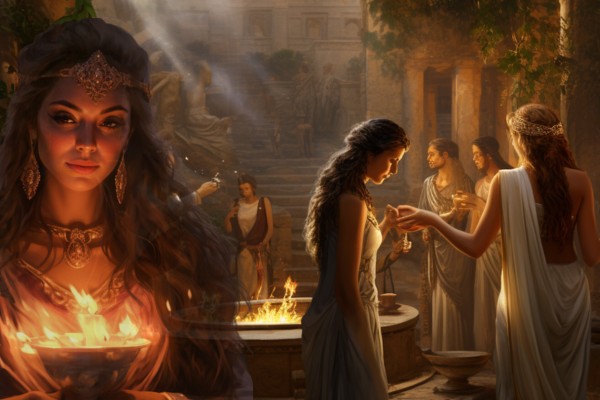
Goddess Hestia is a revered figure in Greek mythology, known as the virgin goddess of the hearth, family, and domestic life.
She was one of the 12 Olympian gods and goddesses.
There are no stories or ancient writings that mention her marriage to any other Greek God.
So she’s assumed to never have been married. And since she was one of only 3 virgin goddesses, she didn’t have children either.
In Greek mythology, her role was to keep the home fire burning, a symbol of the home’s heart and soul.
According to the poet Callimachus, in his “Hymn to Delos,” she has a gentle nature and plays a big role in the household.
Most of her traits can be described as calm, gentle, and supportive.
She was a constant presence in the daily lives of ancient Greeks.
She was part of a powerful family tree that included other Olympians like Zeus, Hera, and Poseidon.
The flame of Hestia, once lit in every city’s hearth, became a symbol of unity and sacred trust.
The idea of home, warmth, and family unity that she embodied continues to reverberate even in modern times.
10 Hestia Facts You Might Not Know
Her role in Greek mythology is profound, yet there are many aspects of her character and story that remain lesser-known.
Here are 10 important Hestia facts that may surprise you:
1. Rarely Depicted in Art
Unlike other deities, images of her are rare in ancient Greek art. Her essence was often captured through symbols like the hearth and fire rather than physical representations of herself.
2. Never Took Part in Conflicts
She is unique among the Olympians for never engaging in any feuds or conflicts, either with mortals or other gods.
Her nature was pacifistic and harmonious.
3. Firstborn but Last Released
One of the more intriguing facts about Hestia is that she was the first child of Cronus and Rhea but the last to be released from Cronus’s stomach.
This unique birth story symbolizes her connection to both beginnings and endings.
4. No Specific Temples
She didn’t have grand temples dedicated to her like other Olympian gods. Her devout worship was more personal, often centered around the home and communal hearths. Despite the lack of temples, every home had a hearth dedicated to her.
5. A Patron of Orphans
She was considered a protector not only of the family but also of orphans and the downtrodden. Her care extended to all aspects of domestic life.
6. An Oath
In ancient Greece, oaths were sometimes sworn by her hearth.
Her sacred flame was considered a witness to solemn promises, reflecting the role of Hestia in truth and integrity.
7. Her Name’s Meaning
Her name translates to “hearth” or “fireside” in ancient Greek, directly connecting her to her domain over the home and the communal fire.
8. A Connection to Vestal Virgins
In Roman mythology, her counterpart was Vesta, as mentioned by the writer Ovid.
The Vestal Virgins, priestesses of Vesta, were charged with maintaining the sacred fire, a practice that mirrors her role in Greece.
9. No Major Love Affairs
Unlike many other Greek gods, she had no major love affairs or romantic entanglements. Her vow of chastity set her apart and underscored her devotion to her divine duties. Both Poseidon and Apollo wanted to marry her, but she refused.
10. Represents Democracy
Her communal hearth, especially in city states, was a sign of unity and democracy. Her flame represented the shared values and governance of the people.
These lesser known facts about Hestia reveal a deity who is both simple and profound.
How was Hestia Born?
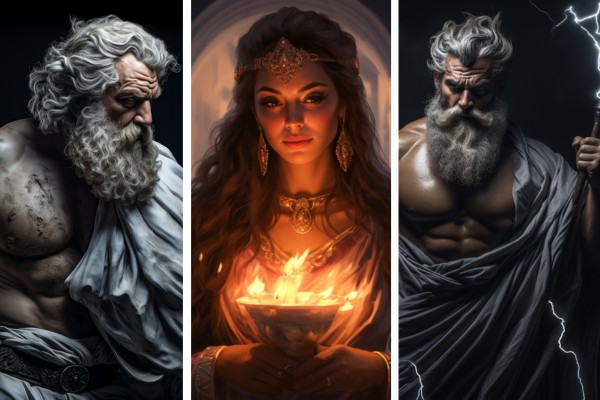
In “Theogony,” Greek poet Hesiod provides details about her birth and her status as the firstborn child of Cronus and Rhea.
Here’s the sequence to how Hestia was born and then rescued:
Cronus’s Fear: Cronus, the ruler of the Titans, feared that one of his children would overthrow him, as prophesied. To prevent this, he swallowed each of his children as soon as they were born.
Her Birth: Hestia was born as the first child of Cronus and Rhea. Naturally, this was symbolic. But following his pattern, Cronus swallowed the goddess shortly after her birth.
Rhea’s Plan: Distraught by the loss of her children, Rhea devised a plan. When her youngest child, Zeus, was born, she hid him away and gave Cronus a stone wrapped in swaddling clothes to swallow instead.
Zeus’s Intervention: When Zeus grew up, he forced Cronus to regurgitate the children he had swallowed. Even though she was the first swallowed, she was the last to be released.
Her Role Afterwards: After she was born and released to be free, she took on her role as the goddess of the hearth and home. Her birth story sets the stage for her calm and stabilizing presence among the often tumultuous Greek gods.
The ancient Greek myths do not specifically pinpoint a geographical location for the question of where was Goddess Hestia born.
Her peaceful nature stands in contrast to the violent circumstances of her early life.
The birth of Hestia, along with her siblings, is a significant myth that’s part of the transition of power from the Titans to the Olympian gods.
Goddess Hestia Myths and Stories
While her birth story is significant, she doesn’t feature prominently in many other myths or adventures.
Her character is more symbolic, representing the hearth and home.
However, there are a few stories and Hestia myths that highlight her role and character:
1. Her Vow of Virginity
She was pursued by both Poseidon and Apollo, who desired to marry her.
Despite their advances, she chose to remain a virgin goddess.
She made a solemn vow to Zeus, promising to remain chaste and dedicate herself to the service of mankind and the gods. Her vow symbolized her commitment to her role as the goddess of the hearth and her focus on community and family.
2. Giving Up Her Seat on Mount Olympus
In a selfless act that underscores the goddess’s gentle nature, she gave up her seat on Mount Olympus to Dionysus when he was accepted as one of the Twelve Olympians.
This act wasn’t about relinquishing power but about ensuring harmony and balance among the gods. She continued to tend the sacred hearth in Olympus, maintaining her important role.
3. Keeper of the Sacred Flame
One of Hestia’s responsibilities was to maintain the sacred flame that burned in the hearth of every home and temple in Greece.
Her priestesses were also responsible for keeping the flame alive, and it was considered a serious offense to let it go out.
This eternal flame was more than just a physical fire; it symbolized the continuity of the community, family bonds, and the connection between the mortal and divine worlds.
4. The First and Last
In ancient Greek rituals and sacrifices, the goddess’s blessing was sought first and last. This unique position emphasized her importance in maintaining the order of things and her role in beginnings and endings. While this isn’t one of the myths about Hestia in the traditional sense, it reflects a cultural belief in her overarching influence on daily life and spiritual practices.
5. Came to the Aid of Prometheus
She helped Prometheus steal fire from the gods for humans. Her aid wasn’t just about lighting hearths; it was a game-changer for humanity. With fire, people could cook, stay warm, and forge tools—essentially kickstarting civilization. That’s why this myth is so significant in Greek mythology.
Those are her most well-known tales.
Her gentle influence may not be as flashy as some of her Olympian relatives, but her role in Greek mythology is a timeless reminder of the essential connections that bind us together.
It’s worth noting that the scarcity of Hestia myths doesn’t diminish her importance in Greek religious life.
Her role was deeply ingrained in daily practices and beliefs, and her influence can still be felt in modern interpretations of home, family, and community values.
Powers of Hestia
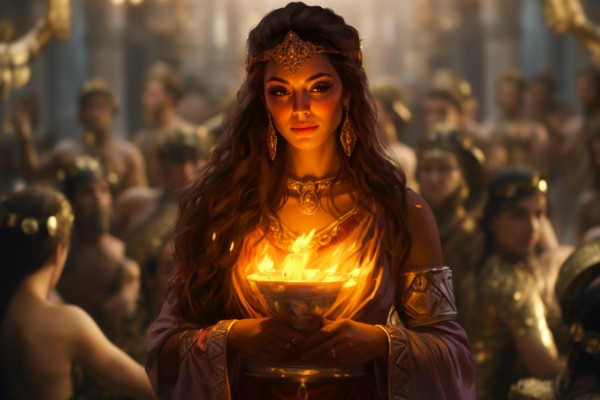
Unlike some other Olympian gods, Hestia powers were not aggressive or flashy.
Instead, they are gentle and nurturing, reflecting her values of family, community, and stability.
Here’s a list of her powers and abilities:
Control Over Fire: As the goddess of the hearth, she had control over fire, maintaining the sacred flame in homes and temples.
Protector of the Home: Another Hestia strength was her ability to protect the home and ensure its safety, symbolizing security and warmth.
Power of Unity: She had the unique gift of fostering unity. She symbolized the family and community bond. Her presence at the hearth ensured peace and harmony, causing families to come together and strangers to become friends around the warmth of the fireplace.
Harmony Among Gods: Her selfless act of giving up her seat on Mount Olympus symbolizes her role in maintaining harmony and balance among the gods. She had these types of quiet abilities like few other goddesses.
Influence Over Community: Her eternal flame symbolized the continuity of community and family bonds, reflecting her influence over social connections.
Immunity to Emotional Manipulation: In a world where emotions can cloud judgment and lead individuals astray, she stands as a beacon of stability. This power of immunity shields her from being swayed by external forces seeking to manipulate or control her emotions. It enables her to make rational decisions based on wisdom rather than succumbing to impulsive feelings or desires.
Inter-Realm Travel: This is another of Hestia’s important powers that allowed her and the other Olympians to travel between Olympus and Earth. She can easily move through these dimensions herself, and she can also transport objects between them.
Ability to Distribute Power: She was able to share her capabilities with others that needed it. This extraordinary gift allows individuals to tap into her divine energy and harness it for various purposes.
Immortality: Like all Olympians, she possesses this extraordinary ability that sets her apart from mere mortals: immortality. This means that she is practically immune to the effects of aging and has remained eternally youthful since reaching adulthood. Unlike humans who experience the inevitable process of growing old, she remains forever unchanged by the passage of time.
In the hustle and bustle of Olympian dramas, Hestia’s special powers may appear understated, yet her influence was still profound and continues even today.
Did She Have a Weakness?
While her gentle and nurturing nature is seen as virtuous, some might interpret her lack of prominence among the Olympians as a weakness of Hestia.
In fact, her focus on the hearth and family led her to relinquish her seat among the twelve Olympians to Dionysus, prioritizing peace and domesticity over power and conflict.
This decision might be seen as a form of weakness by some, but it also reflects her compassionate and selfless nature.
Her character is not marred by scandal or misdeeds in mythology, and the perception of Hestia’s weakness might differ based on personal interpretations.
Her qualities might be seen as softness or lack of assertiveness, but they also constitute her grace, wisdom, and nurturing spirit.
Interesting Facts About Each Hestia Symbol
Here’s every Hestia symbol and its meaning:
The Hearth: The hearth represents the home and the center of family life. As the goddess of the hearth, she oversees the domestic realm.
Sacred Flame: The eternal flame, often found in the hearth of homes and temples, represents continuity, family bonds, and the connection between mortals and the divine.
Veil: The veil is another one of those symbols associated with Hestia that represents her vow of virginity and chastity. This emphasizes her commitment to purity and her spiritual role. This reinforces her unique character as a goddess who chose to remain untouched and dedicated to the service of mankind and the gods.
Kettle or Cauldron: These objects signify nourishment and hospitality, reflecting the goddess’s association with domesticity and sustenance.
Staff or Scepter: This is a symbol of Hestia that signifies her authority and her role in maintaining order within the home and among the gods. It also emphasizes her gentle but firm influence in both the mortal and divine realms. She is not traditionally associated with any weapons. She’s the goddess of the hearth, home, and family, which are generally peaceful domains. This is the closest thing to a weapon that she’s associated with.
Vestal Virgins: In Roman mythology, where this goddess is known as Vesta, the Vestal Virgins were priestesses dedicated to maintaining the sacred flame. They suggest purity and devotion.
Sacred Colors: Given her association with the hearth and domestic life, colors that represent warmth, comfort, and earthiness might be considered representative of her. These could include gold, brown, and earthy red.
Unlike other goddesses, she doesn’t have an animal that symbolizes who she is.
Through each Hestia symbol, her attributes such as family, community, warmth, and stability are amplified.
Personality of Goddess Hestia
As a lesser-known deity among the Olympians, her character might not seem important.
But the greatly admired Hestia personality still resonates with people because of its warmth, unity, and tranquility.
This section delves into the key aspects of her traits and characteristics.
Warmth and Nurturing
Her association with the hearth symbolizes warmth and nurturing. She is often depicted as a gentle and caring figure, one who welcomes all into her presence. Her warmth is not just physical but emotional, offering comfort to those in need.
Guardian of Family and Community
Her commitment to family and community is unbreakable. As the goddess of the home, she fosters connections and ensures that bonds remain strong. Hestia’s personality promoted unity and harmony, making her the ideal guardian of familial relationships.
Modesty and Humility
Unlike other Olympian deities, she is not a figure of drama or conflict. Her modesty and humility set her apart, and she rarely seeks the spotlight. Her quiet strength is a testament to her inner conviction and sense of purpose.
Keeper of the Sacred Flame
Her role as the keeper of the sacred flame emphasizes her spiritual connection. Her duty to maintain this eternal fire symbolizes purity, devotion, and a connection to the divine. It’s a task she undertakes with solemn grace. That’s what many people love about the personality of Hestia.
Serenity and Calmness
Known for inducing calmness, her presence brings peace and serenity. Her calming influence extends to both the divine and mortal realms, making her a beacon of stability in a world often fraught with chaos.
In a pantheon filled with dynamic and often conflicting characters, her gentle and steadfast nature stands as a comforting constant.
Hestia’s personality is a blend of warmth, nurturing, modesty, and spiritual connection.
Is Hestia Good or Bad?
In Greek mythology, Hestia is generally considered a good and benevolent deity.
She symbolizes the warmth and comfort of home. Unlike other gods, she’s not involved in any myths of deception, betrayal, or violence.
And the fact that no weapons are associated with her underscores her role as a peaceful deity.
She’s more about nurturing and less about fighting, which makes her unique among the Olympians.
She never engaged in the schemes and rivalries that many other gods get caught up in.
And based on all the ancient writings that mention her, she didn’t seem to hate anyone.
This keeps her in the “good” column for most people.
So, if you’re looking at it from the lens of Greek mythology, Greek Goddess Hestia is more on the good side than the bad.
Physical Appearance of Hestia
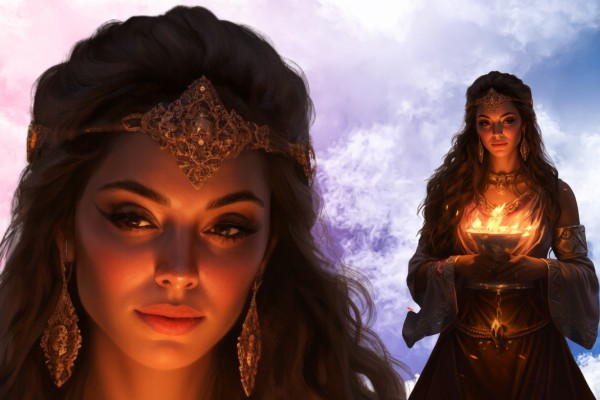
Goddess Hestia’s physical appearance in ancient Greek art and literature is often understated, reflecting her calm and modest nature.
Unlike some other deities who are portrayed with dramatic attributes, her depiction is more serene and simple.
So what does Hestia look like?
Or what might she have looked like?
Clothing
When it comes to clothing, she is often depicted wearing a modest, long robe that covers her entire body. Her attire reflects her chastity and purity, aligning with her role as the goddess of the hearth and family.
Specific colors aren’t strongly associated with her the way they are with some other gods.
But if you’re looking for symbolic colors, white or earth tones would be fitting. White can symbolize purity, which aligns with her eternal virginity. Earth tones represent her connection to the home and hearth.
Attributes
Her features are gentle and composed, with a kind and welcoming expression.
Her eyes often carry a soft, wise look, capturing her nurturing and protective qualities.
While she doesn’t have distinctive symbols like a thunderbolt or trident, she is often shown holding a staff or a simple torch, symbolizing her connection to the hearth and fire.
In some representations, a kettle or domestic object may be included, further emphasizing her role in domestic life.
Overall Image
Hestia’s appearance and image is one of grace, wisdom, and modesty.
Her physical appearance doesn’t overshadow her symbolic importance, and she doesn’t possess the flashy or exotic attributes of some other deities.
Instead, her portrayal resonates with her essence as a nurturing, stabilizing presence, both in the home and within the community.
Her modest attire, calm features, and simple attributes all contribute to a portrayal that captures her essence as the protector of the hearth and the guardian of family and community values.
Hestia’s physical appearance in ancient Greek depictions is aligned with her role as a gentle, loving deity.
Her image serves as a visual reminder of the warmth and stability she brings to those who honor her.
Her Family Tree and Other Relationships
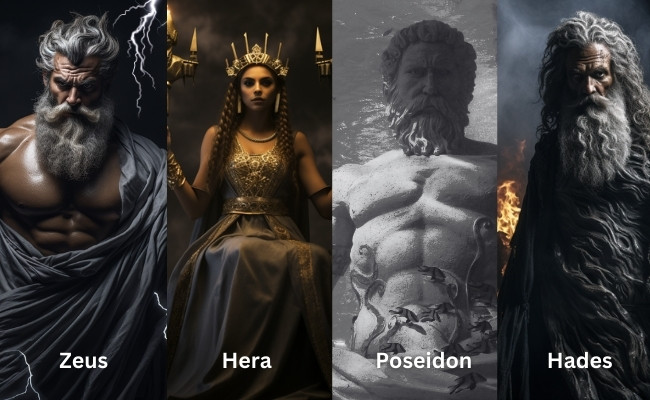
Goddess Hestia’s family tree is rooted in the very core of Greek mythology, connecting her to some of the most powerful and well-known deities.
Here’s a look at her family and how these relationships shape her role and significance:
Parents
Cronus (Father): A Titan who ruled during the Golden Age, Cronus was known for his ruthlessness. He was the father of Hestia and her siblings.
Rhea (Mother): A Titaness and the mother of the Olympian gods, Rhea played a vital role in saving her children from Cronus, who feared a prophecy that one of them would overthrow him.
Siblings
She was the eldest of six siblings, who were key figures in Greek mythology:
Zeus: The king of the gods, Zeus was her brother and a dominant figure in Greek mythology.
Hera: The goddess of marriage and family, Hera shared some thematic connections with her.
Poseidon: God of the sea, Poseidon’s domain was vastly different from the hearth-centered world of this goddess.
Demeter: She was Hestia’s sister with many similarities. For example, Demeter’s connection to the earth was closely connected with her domestic focus.
Hades: Ruler of the Underworld, Hades was another sibling whose realm contrasted sharply with hers.
Family Dynamics
Her family was characterized by intrigue, power struggles, and complex relationships.
Despite the often tumultuous nature of her family, the goddess herself remained a figure of stability and calm.
She chose to remain a virgin goddess, devoted to her role as the keeper of the hearth.
Her relationship with her family was generally harmonious, and she didn’t engage in the feuds and rivalries that often marked the interactions among the Olympians.
Her decision to give up her seat on Mount Olympus to Dionysus, a later addition to the pantheon, is a testament to her selflessness and dedication to harmony.
Goddess Hestia’s family places her at the heart of Greek mythology, connecting her to powerful deities and epic stories.
Who Were Hestia’s Friends and Enemies?
Her commitment to chastity and her focus on the hearth and family aligned with the virtues of some other Olympians like Apollo and Artemis.
So they could be seen as close in spirit, if not described as Hestia friends in the traditional sense.
Goddess Athena’s wisdom and emphasis on virtuous living might have resonated with her own values.
Though there are no specific myths detailing their friendship, they shared similar principles.
She helped Prometheus give fire to humans, so he was a friend.
Hestia’s friendship with other gods and goddesses is not as well-defined as those of some of her more flamboyant counterparts.
And that’s the same with her enemies. They aren’t defined at all in any of the Greek myths.
Her virtues and her role in the home might suggest a connection with deities that shared similar values, as well as a unique relationship with the people who worshipped her.
Her Presence In Modern Culture
While the temple of Hestia and ancient rituals have faded somewhat, her influence continues to permeate modern culture.
Her symbolism as the goddess of the hearth has found its way into literature, art, and even psychology.
Authors and artists often draw on her themes of home, family, and community to explore contemporary issues.
The hearth, once a literal fire in ancient Greece, now symbolizes the emotional warmth and connections that sustain us.
Hestia’s legacy isn’t just a historical curiosity; it’s a living part of our cultural fabric.
The values she embodies—harmony, warmth, and domestic stability—are as relevant today as they were in ancient times.
Whether it’s the joy of family gatherings, the comfort of home, or the broader sense of community, her essence can be felt.
Her enduring appeal reminds us of the timeless importance of connections, both with our loved ones and with the world around us.
From the myths of ancient Greece to the narratives of today, Hestia represents the universal human longing for home, warmth, and community.
Her legacy continues to inspire, offering a gentle reminder of the simple yet profound connections that enrich our lives.
Conclusion About Goddess Hestia
The stories and symbols of Goddess Hestia weave a rich tapestry of values that transcend time and geography.
From her origins as a daughter of Titans to her enduring presence in modern culture, her gentle influence has shaped our understanding of home, family, and community.
She stands as a unique figure in Greek mythology, one whose powers are not of conquest or grandeur but of harmony, warmth, and stability.
The flames that never went out, and the ways she’s been reimagined in contemporary art and literature all speak to a universal truth about Hestia: the connections we make, the homes we build, and the love we share are central to our human experience.
Her eternal flame invites us to gather around, to celebrate our common bonds, and to reflect on the simple yet profound joys of being together.
Her story serves as a warm invitation to reflect on the connections that make us human.
All the Goddess Hestia facts and myths listed above are not mere relics of a bygone era; they are living reminders of what truly matters, echoing in our hearts and homes even today. That’s her power.
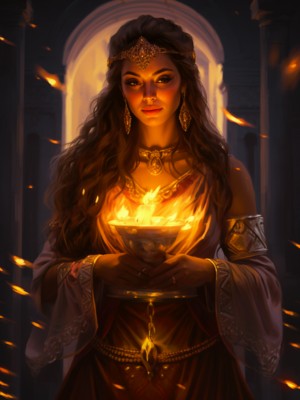
2024 All rights reserved.
